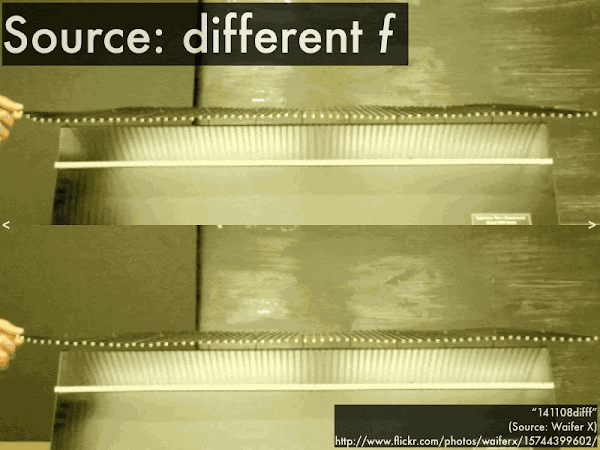Cuesta College, San Luis Obispo, CA
Students have a weekly online reading assignment (hosted by SurveyMonkey.com), where they answer questions based on reading their textbook, material covered in previous lectures, opinion questions, and/or asking (anonymous) questions or making (anonymous) comments. Full credit is given for completing the online reading assignment before next week's lecture, regardless if whether their answers are correct/incorrect. Selected results/questions/comments are addressed by the instructor at the start of the following lecture.
The following questions were asked on reading textbook chapters and previewing a presentation on waves.

Selected/edited responses are given below.
Describe what you understand from the assigned textbook reading or presentation preview. Your description (2-3 sentences) should specifically demonstrate your level of understanding.
"The fundamental frequency of a string depends on the wave speed v which depends on its tension and thickness, and also depends on its length L."
"How waves travel and the difference between transverse and longitudinal waves."
"Longitudinal waves travel along an object instead of in cross section to it. Linear mass density stays proportional with the same string if it is cut."
"Frequency and speed are independent of each other, but wavelength is dependent on these two values. When a string is set to oscillate at a frequency that is a fixed integer multiple of its fundamental frequency, standing waves and nodes form."
Describe what you found confusing from the assigned textbook reading or presentation preview. Your description (2-3 sentences) should specifically identify the concept(s) that you do not understand.
"Standing waves are confusing."
"I found the difference between the independent and dependent parameters confusing. I also don't really understand standing waves and resonance."
"There wasn't really anything I found confusing. A few examples might help though."
"How thickness of a string effects the wavelength or frequency."
"How cutting the string would change the linear mass density."
A string of a given length has a certain linear mass density µ (Greek lower-case "mu") value. If this string is cut in half, then its linear mass density µ value will:
decrease. *********** [11] remain constant. ****************************** [30] increase. ******* [7] (Unsure/lost/guessing/help!) ******* [7]

(Only correct responses shown.)
Faster wave speed v: there is (approximately) a tie. [56%]
Longer wavelength λ: there is (approximately) a tie. [38%]

(Only correct responses shown.)
Faster wave speed v: there is (approximately) a tie. [43%]
Longer wavelength λ: top wave (low frequency f). [78%]

(Only correct responses shown.)
Faster wave speed v: Along the right apparatus. [25%]
Longer wavelength λ: along the right apparatus. [83%]
Higher frequency f: there is (approximately) a tie. [72%]
For transverse waves on a string, classify each of these parameters are being "independent" (able to be changed without affecting other independent parameters), or "dependent" (will be changed when independent values are changed).
(Only correct responses shown.)
Amplitude A: independent. [63%]
Wave speed v: independent. [36%]
Frequency f: independent. [43%]
Wavelength λ: dependent. [60%]

thinner. ************************************** [38] thicker. ****** [6] (There is a tie.) **** [4] (Unsure/lost/guessing/help!) ******* [7]
After these same-length guitar strings are plucked (assuming that their tensions are approximately equal), the __________ strings vibrate at a lower fundamental frequency.
thinner. ***************************************** [41] thicker. ****** [6] (There is a tie.) [0] (Unsure/lost/guessing/help!) ******** [8]

decrease. ************ [12] not change. *********** [11] increase. **************************** [28] (Unsure/lost/guessing/help!) **** [4]
After the bass string is plucked, sliding a finger down to decrease its length would __________ the fundamental frequency of the string.
decrease. ********** [10] not change. *********** [11] increase. *************************** [27] (Unsure/lost/guessing/help!) ******* [7]
For standing waves on a string, classify each of these parameters are being "independent" (able to be changed without affecting other independent parameters), or "dependent" (will be changed when independent values are changed).
(Only correct responses shown.)
Wave speed v: independent [42%]
String length L: independent. [41%]
Fundamental frequency f1: dependent. [49%]
Ask the instructor an anonymous question, or make a comment. Selected questions/comments may be discussed in class.
"Regarding the question about independent versus dependent characteristics of waves, isn't that subjective based on how you manipulate equations? Wave speed v could be dependent on frequency f and wavelength λ, or λ could be dependent on v and f, or f could be dependent on λ and v." (Mathematically, yes. But rearranging an equation mathematically does not necessarily carry through the proper transitive relations between physical properties. Consider the Dormouse from Alice in Wonderland: "You might just as well say that 'I breathe when I sleep' is the same thing as 'I sleep when I breathe!'")
"If I have 90/100 lab points, but I had 10 extra-credit lab points, does that mean I still get the maximum 100 possible points for the lab portion of this course?" (Yes.)
"I think I answered all these questions wrong." (We will try to fix that during class.)
"Can we go over all the parameters from this section and how they affect the wave speed and fundamental frequency closely in class?" (Ditto.)
"Does everything have a resonant frequency in including the human body? Is this related to the so called 'brown note?'" (Yes, but matching that resonant frequency for human bodies seems to cause nausea and breathing difficulties, rather than loss of bowel control.)
"NO MORE RANKINGS!" (OR ELSE HULK SMASH!)
No comments:
Post a Comment